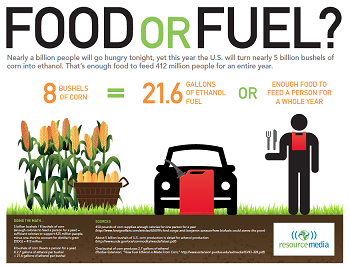The Corn Identity: The US Will Make Ethanol Out Of Enough Corn To Feed 412 Million People
 The US corn crop, in the in the height of its vulnerable pollination phase, is already under siege from intense heat and devastating drought. Experts are continuously revising predicted crop yield lower and lower. In fact, as of July 11th, this year’s corn crop is no longer projected to be history’s largest. At the same time, almost 1 billion people world wide are going hungry. However, plans remain in place to use about 40% of America’s corn crop, the world’s largest, for biofuel purposes.
The US corn crop, in the in the height of its vulnerable pollination phase, is already under siege from intense heat and devastating drought. Experts are continuously revising predicted crop yield lower and lower. In fact, as of July 11th, this year’s corn crop is no longer projected to be history’s largest. At the same time, almost 1 billion people world wide are going hungry. However, plans remain in place to use about 40% of America’s corn crop, the world’s largest, for biofuel purposes.The nearly 5 billion bushels of corn that will be cordoned off for to create ethanol could feed about 412 million people for an entire year. Instead, it will be turned into 13.5 billion gallons of corn ethanol. This is a problem because:
1.Life cycle studies show that corn ethanol ranges from barely better than petroleum fuels to significantly worse, especially if you take into account land and water use issues, increased deforestation, and increased fertilizer use.
2.Corn ethanol contributes to rises in food prices because of competition for arable land to grow food. With more corn for biofuels taking up that space, the price of grains and other agricultural products increases.
3.For many in the developing world, rising prices mean they don’t eat. People in poor countries, especially in import-heavy sub-Saharan Africa, feel the impact of rising food prices far worse than in developed countries. This is because they spend so much more of their income on food….Poor people do not have that luxury. As the UN Reported (in October), 26 countries, mainly in sub-Saharan Africa, are still at extreme risk of hunger, with biofuels playing a significant role in exacerbating the problem.
4.Climate change mitigation from biofuels will be “very limited” before 2050. “We will not have any greenhouse gas savings for the next 20 years…because they are working with first generation crops,” according to Mahendra Shah, an advisor to Qatar’s food security program.
5.By focusing our national investments on corn ethanol, we prevent other technologies, including other biofuels such as cellulosic ethanol and micro algae biodiesel, which are low greenhouse gas emitters, from competing with corn ethanol.
President Bill Clinton believes that an over emphasis on corn ethanol could lead to food riots. A point underscored by the fact corn futures are less than 15 cents from an all time high.
The only reason environmentalists and clean energy advocates even tolerated energy deals with corn ethanol mandates is the hope that jumpstarting the infrastructure for corn ethanol would pave the way for next-generation cellulosic ethanol. That turned out to be a mistake (see “Are biofuels a core climate solution?”).
We have gone far beyond what is tenable. Yes, peak oil (and the energy-intensive nature of food production) means that oil prices will rise in tandem with food prices, thus increasing the profitability of biofuels. And yes, we are a rich country, the breadbasket of the world, politically far more impervious to higher food prices than higher oil prices.
But as population grows, developing countries’ diets change, and the extreme weather of the last year increasingly becomes the norm in a globally warmed world, food insecurity will grow and our biofuels policy will, inevitably, collapse. It must.
There are other potential biofuel sources. Some are food by products, others aren’t even food at all. Its time that we realize the failings of corn ethanol, stop devoting so much of a valuable resources to this wasteful project, and feed the hungry.
You can return to the main Market News page, or press the Back button on your browser.

